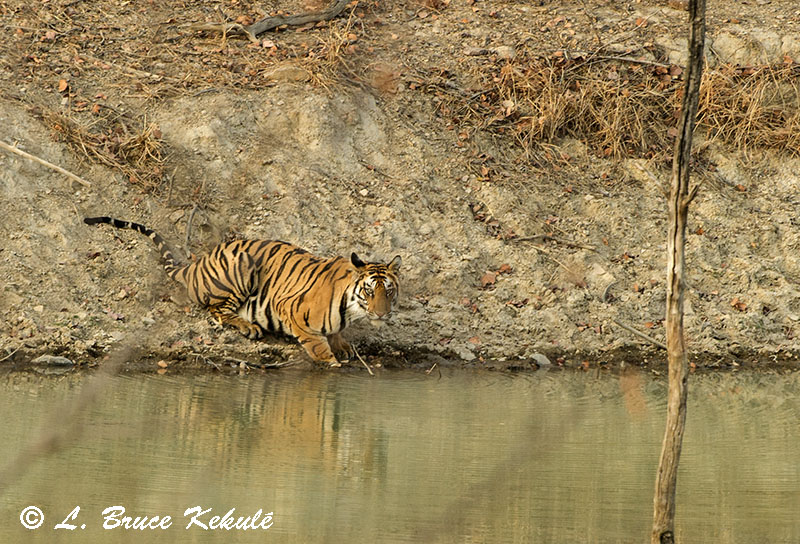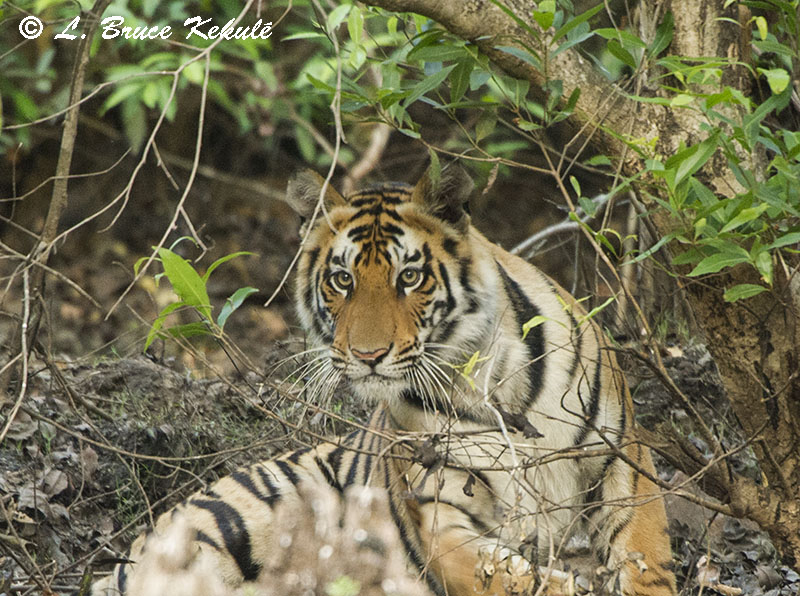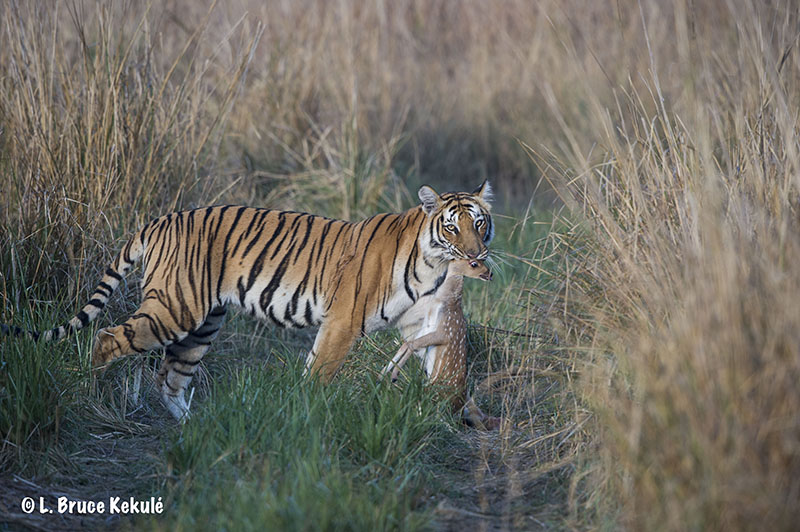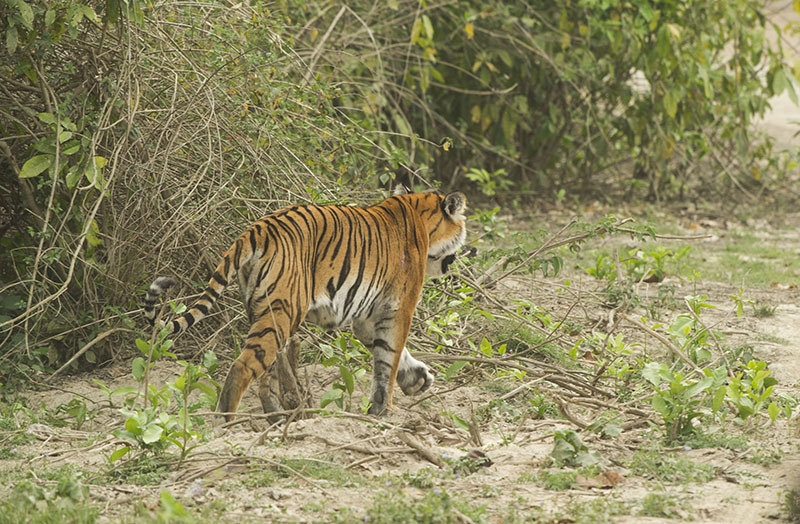Posts Tagged ‘Asian big cat’
Nikon D700 catches an Indochinese tiger
A female tiger returns again…!
About five months ago, I set a Nikon D700 DSLR camera trap at a hot spring deep in the interior of the Western Forest Complex of Thailand. I managed to get some nice shots of a female Indochinese tiger as she walked back and forth, and up and down to the mineral seep. I then moved the D700 to another tree close by for a better capture and composition. When I got to my camera last week and checked my files on the Nikon, I almost fell off the log I was sitting on. There she was again but this time with expression, behavior, focus and exposure perfect. This shot is one of my best all time tiger camera trap images….great success at last at this new location…Enjoy…!
Camera: Nikon D700 full-frame body
Lens: Nikon 35mm manual lens (very old)
Sensor: Snap Shot Sniper SSII
Case: Pelican 1150
Box: Aluminum ‘elephant proof’ housings for camera, flashes and sensor
Flashes: Two Nikon SB-28s
Exposure: 1/200th – ƒ5.6 – ISO 400
The first shot in the string…!
Forty Tigers…!
India’s amazing big cats
About 20 years ago when I began wildlife photography, I dreamed of going to India to photograph tigers. The rich biodiversity found on the sub-continent is without equal and boasts the largest population of the big striped cat in the world.
My first tiger in India; one of four cubs around ‘Telia Lake’ in Tadoba-Anhari-2013…!
Tiger cubs sparring in Telia Lake, Tadoba-Anhari..a once in a lifetime shot…!
The first photographic book in my library on wildlife is titled ‘Wild India’ by the renowned British photographer, Gerald Cubitt and published by New Holland in London. He traveled all over India capturing most of the wild animals on film including the majestic tiger. The urge to go after this big cat burned in me for many years.
‘Telia lake’ cub up-close on my third morning in Tadoba…!
In late-2009, I photographed an Indochinese male tiger (though the lens) in Thailand from a blind which is a very difficult feat to accomplish. These carnivores are so smart and extremely wary, and tough to see in the wild let alone photograph. I also camera-trapped many tigers in several protected areas situated around the Kingdom.
Tiger cub near the road in Tadoba…!
Tadoba-Andhari Tiger Reserve – Maharashtra State – Count: 11 tigers…!
Tiger cub hunting chital at Telia Lake…she was hesitant and missed the deer…!
But the desire to visit India burned in me until I finally made my first trip in April-2013 to Tadoba-Andhari Tiger Reserve and National Park. I was with my good buddy Luke Stokes who is an up and coming photographer in his own right, and he lives in Thailand like me. We made the flight from Bangkok to Hyderabad, and then the 9-hour taxi ride to the park. I was finally in the ‘Land of the Tiger’…!
Old ‘Wagdoh’ (Scarface) at Telia Lake…he still is the dominant male in this area…!
At the time, Tadoba was one of the top reserves for tiger sightings in India with four tiger cub sisters growing up around Telia Lake. On our second morning, I managed to get a once in a lifetime shot of two sisters sparring in the water. I was certainly off to a good start.
‘Wagdoh’ on the third morning by the road…!
‘Wagdoh’ at the lake the next day,,,!
The next morning, we bumped into the dominant male and father of the four sisters; old Wagdoh (Scarface) out on the road, and a day later, photographed him at the lake. We also got the other two sisters around the lake during the week. Then, we got a breeding pair over in Tadoba National Park as they went about their natural business.
A breeding pair over in Tadoba National Park…!
On our next to the last day in the park, one of the sisters (the jumping tiger facing me) made an appearance near the road to say goodbye, and I got some wonderful close-up shots of her.
Tiger cub by the side of the road saying goodbye…she is the same tiger facing me in the sparring shot…!
Then in early-2015, I made a second trip to Tadoba and managed to get three tigers including Maya T12, Choti Tara T17 and finally, ‘Gabbar’ or ‘Leopard Face’ T42 that had been injured in a fight with another male tiger.
‘Maya’ or T12, is a mature tigress in Tadoba, 2015…!
‘Choti Tara’ or T17, another mature tigress on the road in Tadoba National Park…!
‘Gabbar’ or ‘Leopard Face’ or T42 with a radio collar cooling off in a pond in Tadoba National Park…he was badly injured fighting with another male…!
Ranthambore Tiger Reserve – Rajasthan State – Count: 6 tigers…!
In November-2014, I visited Ranthambore that is India’s most famous tiger reserve. On the third morning of my 7-day safari, I managed to photograph the very infamous dominant male tiger named ‘Ustad’ or T-24, and then later that day got another male named Zalim or T-25, and one of his cubs (he was looking after two cubs at that time).
The infamous ‘Ustad’….I caught him in Zone 1 on my third day…!
Then the next day, I got Ustad’s son ‘Sultan’ or T-72 two days in a row. Finally, I snapped ‘Krishna’ or T-19, an equally legendary tigress. Shortly after that, ‘Ustad’ was thrown in a zoo (jail) on trumped-up charges of killing a forest guard. It became a world-class scandal. Poor ‘Ustad’ was out and never to be photographed in the wild again..!
‘Zalim’ out hunting…he had left his two cabs in the bush…!
‘Zalim’s’ cub in thick bush. This was the only shot I got of this young tiger…!
‘Sultan’ looking bored in Zone 6…one of my favorite tiger shots….! A huge crowd of hundreds of Indian tourist had should up behind me…!
‘Sultan’, son of ‘Ustad’ the next morning, also in Zone 6…!
‘Sultan’ saying goodbye in Zone 6…!
‘Krishna’, a tigress near the Ranthambore Lake…!
Bandhavgarh Tiger Reserve – Madhya Pradesh State – Count: 7 tigers…!
When I made my first trip to Bandhavgarh in November-2014, I was not lucky and did not see any tigers over a four-day visit except for some pug-marks. But in early-2015, I made a second trip to the park and on the finale day of my 4-day safari, got a sub-adult male in the morning and then in the afternoon, photographed ‘Dotty’, a very famous tigress in Zone 2.
A sub-adult male tiger in Zone 2 in 2015…a lucky encounter after 4 days of no sightings….!
A tigress named ‘Dotty’ in the afternoon on day four…another lucky shot…!
In early March of this year (2017), I made my third visit and caught a sub-adult male in Zone 3 on the very first afternoon. The next morning, I bumped into ‘Spotty’ (sister of ‘Dotty’) and two of her cubs (8-9 months old) in Zone 1. On my next to the last safari, I bumped into ‘Solo’ in Zone 2, a mature female at distance for a nice tiger habitat shot as she sat in the morning sun looking for prey.
A sub-adult male on my first day in late afternoon on March 2017 in Zone 3….!
On my second day, we bumped into ‘Spotty’ (sister of ‘Dotty’) and her two cubs in Zone 2…!
‘Spotty’s’ cub on the road in Zone 2…!
‘Spotty’s’ other cub following her sibling and mother….!
A tigress named ‘Solo’ out in the morning sun waiting on prey….!
Kanha Tiger Reserve – Madhya Pradesh State – Count: 1 tiger…!
In early-2015, I visited Kanha Tiger Reserve. Sightings were down at that time but I finally was able to catch the ‘Budbudi’ female tiger one morning as she walked, roared and scent marked looking for a mate. She came real close to our jeep and crossed in front of us, and then posed on the other side.
‘Budbudi’ female tiger marking territory in Kanha…!
‘Budbudi’ female on the other side of my jeep…!
Pench Tiger Reserve – Madhya Pradesh State – Count: 8 tigers…!
In early-2015, I also traveled to Pench and on the very first morning, got the ‘Patdev’ female tigress and photographed her again in the afternoon. The next morning, I got a sub-adult male. On the third morning, I managed to get some great close-up shots of the very famous ‘Collarwali’, a female tigress with seven litters and 26 cubs to her name.
‘Padtev’ tigress in Zone 1 on the first morning in the bush…!
‘Patdev’ tigress in Zone 1 in the afternoon (second sighting that day)…!
Sub-adult male on my second morning…!
‘Collerwali’ on the road in 2015 early the third morning….!
In early-2016, I made a second trip to Pench and photographed ‘Collarwali’ and her two cubs. Then, I got the famous ’Raiyakassa’ male tiger the next afternoon.
‘Collarwali’ still sporting a collar in the early morning on the first day in 2016…!
‘Collarwali’ yawning out in the morning sun..
‘Collarwali’s’ cub and mother resting in the morning…!
‘Raiyakassa’ male tiger and ‘Collarwali’s’ mate in Pench near the lake on March. 2016
I just finished my third trip to Pench but after four days, I left empty-handed. The Forest Department had just burnt fallen leaves along all roads to create fire-breaks and I believe this pushed all the tigers into the interior. There were no sightings in the park at all since the burning.
Panna Tiger Reserve – Madhya Pradesh State – Count: 2 tigers…!
In early-2016, I also traveled to Panna Tiger Reserve. As most people know, Panna lost all their tigers due to poaching sometime in 2009. The Forest Department decided on a reintroduction program and moved several tigers including a female named T-1 from Bandhavgarh into Panna.
A female cub from the ‘T-1 female’ introduced from Bandhavgarh Tiger Reserve…!
On my very first afternoon, I was lucky and photographed T-1’s female cub at a waterhole. On my third and final day, I got T-1’s other female cub at another waterhole.
Another one of ‘T-1’s’ cubs. This was on my way out of the park…she said goodbye…!
Corbett Tiger Reserve – Utterakhand State – Count: 3 tigers…!
Of course, no trip to India would not be complete without visiting Corbett Tiger Reserve in Northern East India. This park is named after the very famous Jim Corbett (naturalist, photographer, author and hunter of many man-eating tigers and leopards in India).
In early-2015, I managed to catch a young female tigress chasing chital deer in the Dhikala grasslands not far from the camp. Throughout that day, we saw her several times.
A young tigress in the Dhikala grasslands chasing chital deer…2015…!
‘Parrwali’ tigress near the Ramgangar River with a chital fawn in her jaws…2016…!
Parrwali on ‘Sambar Road’ not far from Dhikala camp…!
In early-2016, I photographed Corbett’s most famous female tiger at the moment named ‘Parrwali’ with a chital fawn kill in her jaws across the Ramgangar River. This is my best shot of a tiger in India so far; predation is tough to get and I was lucky. I then caught Parrwali and an un-named sub-adult male tiger on ‘Sambar Road’ the next two days.
A mature male tiger crossing the road not far from Dhikala camp…a habitat shot…2017…!
I have just returned from a trip to Corbett in Dhikala and Birjani areas. On the second morning in Dhikala, a male tiger crossed the main road through the ‘Sal forest’ in mid-morning not far from camp and I was able to get some nice shots in the morning sun. In Birjani, I did see the famous ‘Sarmilly’ female tiger in the afternoon on the second day but she stayed hidden for the most part and I did not get a photo.
Kaziranga National Park – Assam State – Count: 0 tigers…!
In Early-2015, I traveled to Kaziranga, one of India’s greatest wildlife reserves with some 2,400 Asian one-horned rhinos, 1,300 wild water buffalos and 1,000 Asian elephants. There are suppose to be about 200 tigers in the park. However, I did not get a tiger but only a set of pug-marks one morning.
Satpura Tiger Reserve – Madhya Pradesh State – Count: 0 tigers…!
In early-2015, I traveled to Satpura but did not see a tiger. They are very difficult to see here.
Vanghat (Private) Eco-lodge – Utterakhand State – Count: 1 tiger…!
I have always wanted to use camera traps in India but the Forest Department does not allow outsiders to do this in any of the tiger reserves, and for the most part is set aside for their own research teams. After some consultations with the owner of an eco-lodge near Corbett, it was decided to set a DSLR camera trap near the Ramgangar River up a mountain ridge line. I managed to get a great shot of a young female tiger on the second night.
Young tigress camera trapped in the Corbett landscape up a ridge line near the Ramgangar River….2016…!
You can say I’m hooked on photographing tigers in India. I’ve just finished my sixth trip and got 6 tigers this time. I look forward to future visits to add more tiger shots to my files.
Note: This number is the actual tigers photographed with some duplication. Nikon D3s, Nikon D4s, D3oos bodies and Nikon 200-400 and Nikon 70-200 Telephoto lenses were used plus a Nikon D3000 for the camera trap shot…!!
Nikon D700 catches an Indochinese female tiger sporting a radio collar…!
Tiger research in the Western Forest Complex (WFC) of Thailand
Indochinese tiger female sporting a ‘radio collar’ at the tiger log…!
First off, I want everyone to know that I’m not against research that is extremely important for knowledge of the natural world. The practice of studying animals and behavior is needed to understand how Mother Nature’s beings and biospheres live in a complex world. Some people might take offence to the relevant facts stated below but things need to change quickly in order to really save the tiger, and other creatures and ecosystems of Thailand’s natural heritage.
Close-up: A serial numbered tiger and the number can be seen written on the collar.
Frankly, there are some projects that are on-going and not up to standard that have caused many tiger deaths, directly and indirectly. Such is the ‘tiger research’ carried out that is mediocre to very poor to say the least. The researchers working on tigers here have a track record that simply is not acceptable…!
Many problems have come to the forefront about the system of capturing the big cats with snares and then shooting them with darts to sedate them. Some tigers have escaped the snare and ended up with a limp because of pulled joints, tendons and ligaments. This is a serious problem as the cat now cannot chase down its normal prey like deer and pigs, and quickly dies of malnutrition. Botched tiger captures using wrongly administered drugs to sedate tigers has also been noted. The tigers could not be revived and the animals were simply buried and the news suppressed.
Serial numbered tiger – #164 900 – 2014
Another problem of making broad statements about the amount of tigers in certain areas and broadcasting this plus other pertinent ‘radio collaring’ information on national TV channel is like sounding the death knoll to come and get these magnificent creatures. There are still many bad elements in our society and these cold-blooded killers think nothing about dispatching a tiger for its bones used in the making of Chinese medicine and wine. It’s all about money and human greed…!
This has also happened in India where researchers published their work in the local newspapers, and on the radio and TV how many tigers were in Panna Tiger Reserve and within one year, the cats completely disappeared as poachers moved in and systematically killed them all in one quick swoop. Tigers like all big cats, come to carrion and if a carcass is tainted with poison, it’s just a matter of time before the whole local wild feline population is wiped out. They disappeared under the forestry staff and researcher’s noses. Because it is in open forest, other animals like bears, civets, all the cats, wild pigs. vultures also perish. How could this happen..?
Other stories on the Internet can be found about tigers with collars not breeding very well was also documented in India. Finally, researcher’s laptops have been hacked into and important GPS data on tiger whereabouts was stolen. These high tech poachers can kill a population in a jiffy.
Putting collars on young tigers is a serious no-no but this has been done here in the name of research with the researchers finding the collar had stopped moving and the cub found dead having quickly out-grown the leather strap suffocating it. Another serious occurrence of taking tiger cubs out of their den for research data gathering purposes, and then coming back a second time to photograph the researchers holding the cubs. The mother tiger abandon the den and the cubs ended up dead. This is a serious breach of protocol and the National Parks law…!
Needless to say, these people continue to carry on like nothing has happened but these are facts backed-up by reliable sources and boots on the ground. And what is really worrisome is the fact that several international NGOs and a U.S. university are backing this program.
Other tribulations like bringing domestic cattle to act as ‘tiger bait’ was ongoing until recently, and who knows if any disease like ‘foot and mouth’ or ‘anthrax’ was introduced into the sanctuary during this time. The cattle were purchased locally (sometimes, diseased cows are illegally imported from nearby Burma). This baiting technique was used for several years and the researchers brought these domesticated cattle in by the truckload. A cow was then tied to a stake and a bamboo enclosure built around it with only one opening and they built scores of them in the forest. Of course hay and water were provided to the cow. A tiger would step in and maybe get snared. This practice fortunately has been suspended. This is just another breach of the law where domesticated animals are not allowed in wildlife sanctuaries that have been set aside for biodiversity and research.
The researchers already have loads of data including identifying individuals and home-range information through camera trapping, plus the data from the 8-10 collared tigers. My feeling is that the collaring process should cease as there are far to few tigers left in the wild. No amount of research can justify even one tiger getting killed in the name of science. There are only about 3,200 left in the world, and maybe less than 250 in Thailand. It is time to seriously concentrate on protection and enforcement only and less emphasis put on research. We already know there are tigers in WFC, one of the greatest tiger reserves in the world.
Most unfortunate are the old laws that apply to wildlife and protected areas that seem to perpetuate lawless people from being put away in jail. Most poachers and forest product gatherers get light fines and a slap on the wrist when apprehended in national park land, even with solid evidence. The park officials must bring all poachers to the local police station, which then starts another wheel of corruption at a higher level. If the case gets into the courts, pay-offs are used to get light sentences and sometime off ‘Scott-free’. There are very few convictions and long-term jail sentences although once in awhile, some do end-up in jail as a consequence but the ratio of convicted poachers to released offenders is small.
The biggest problem is simply there are not enough ranger personnel to look after these remaining tiger reserves and, budgets are slim and sometime non-existent. My biggest concern is that everything will come too late to save the tiger from extinction. Lawmakers and budget people need to get their head out of the sand but that will take an act of god (AOG) to get going in a culture that thrives on corruption.
One of the most important things to get established in Thailand is a dedicated ‘ranger school’ so that the ranks can be filled with well trained and equipped personnel. The present ranger numbers need to be increased by over 100%. Several revolving 5-man teams need to patrol with men always in the forest from their respective ranger stations. This is the only way to keep the poachers at bay. Again, this will basically need an AOG to get done.
Once again, I’m not against research, but a line must be drawn in the sand. Too much money and effort goes towards this activity and very little into protecting the wildlife and biospheres here that the researchers are researching. This is just not right and I for one, want to try and change things here so that wildlife at least gets a fair shake.
At the end of the day, the only thing that will help Thailand’s tigers in the long run is also a serious look into the middlemen and end-users of tiger bones and other forest products. These people must be apprehended and the masses educated to see the fallacy in using wild animal parts to cure ailments. The Asian medicine trade is still in full swing and will be next to impossible to stop.
But this practice has been going on for hundreds to thousands of years in China where the tiger first evolved two million years ago. The Chinese tiger is extinct in the wild but they now have loads of ‘tiger farms’. Unfortunately, wild tigers are the most sought after for the black market trade. It is a bad situation out there that seems to be getting worse and on the increase due to the ever-increasing population explosion. Sadly and in the long-run, the tiger will simply disappear if things do not change..!




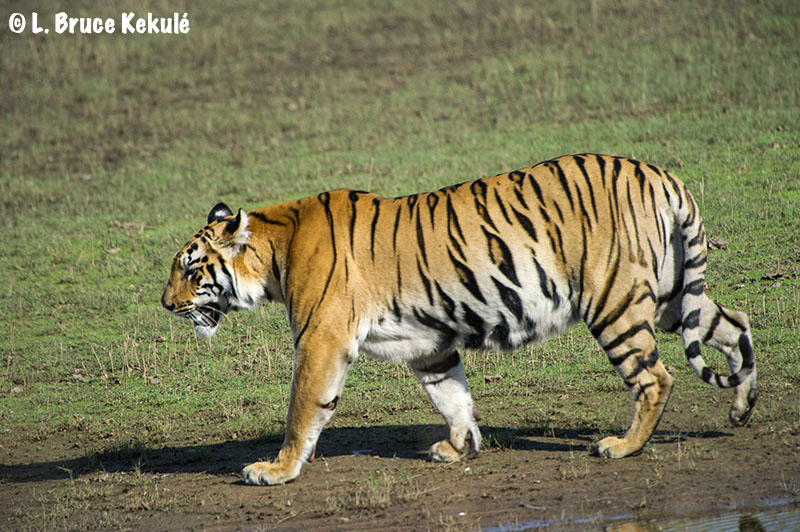




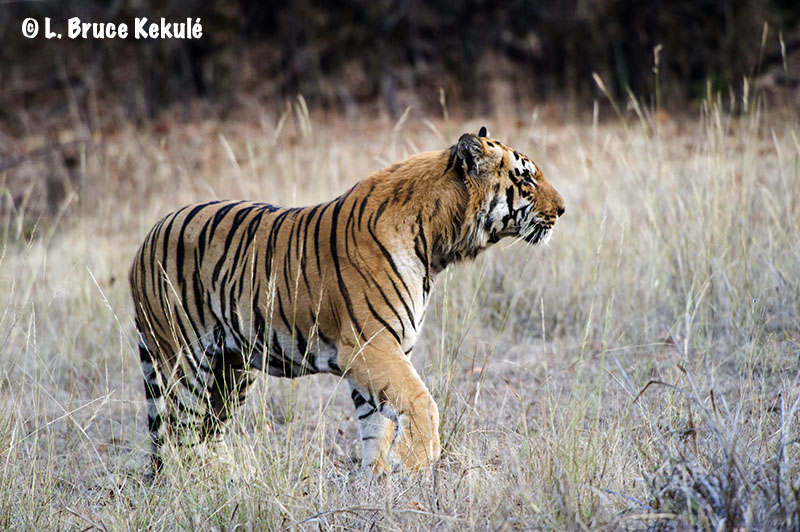




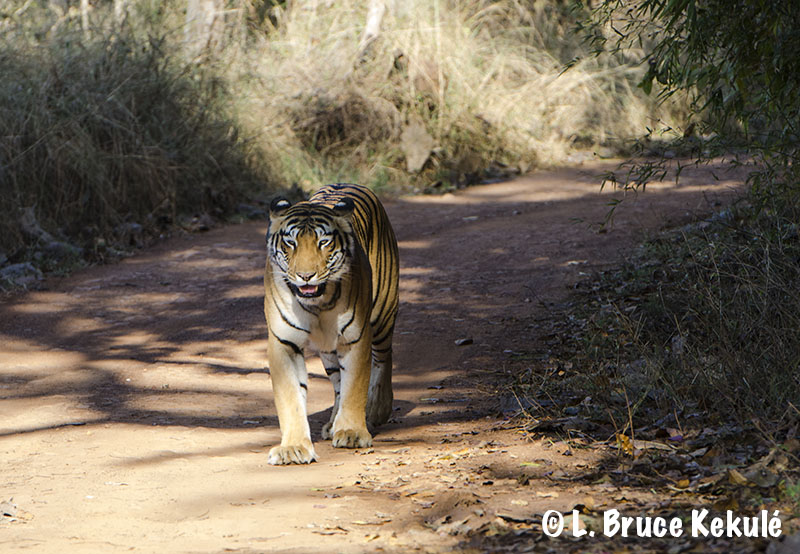


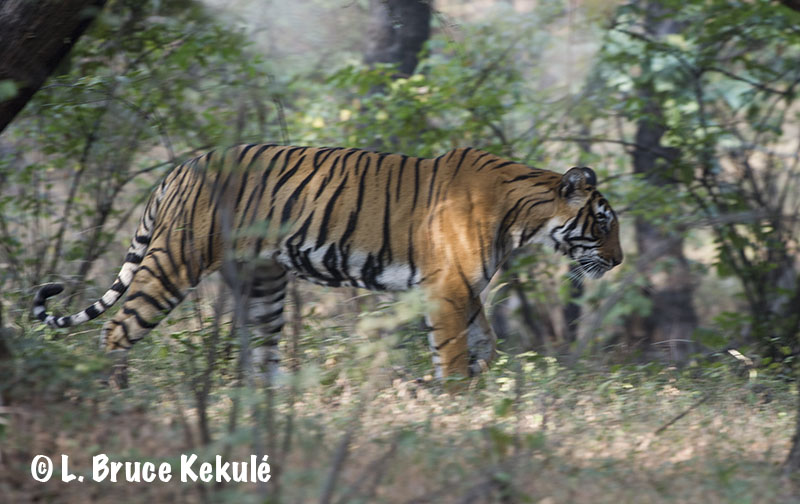

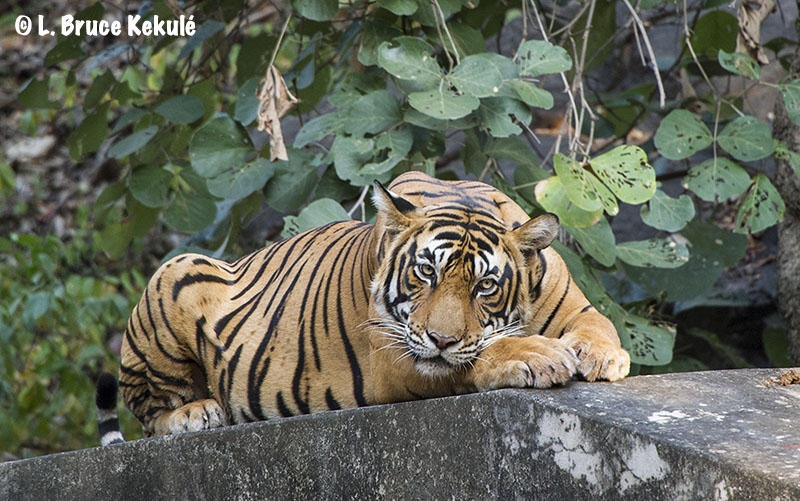

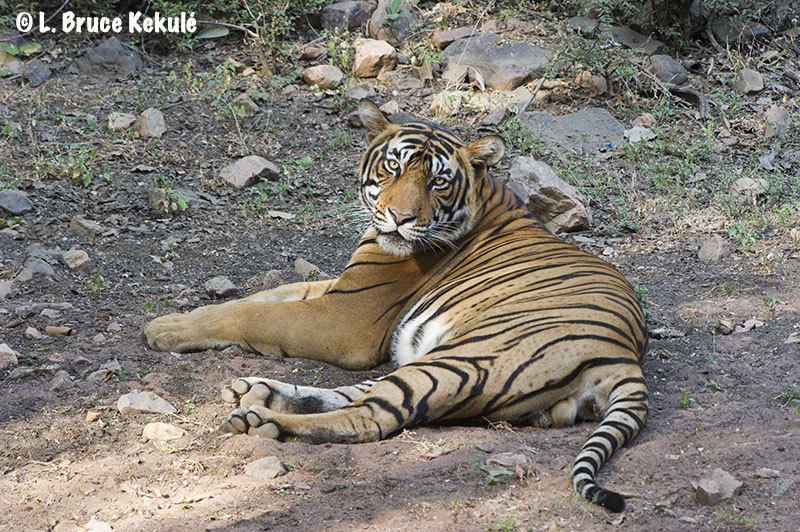






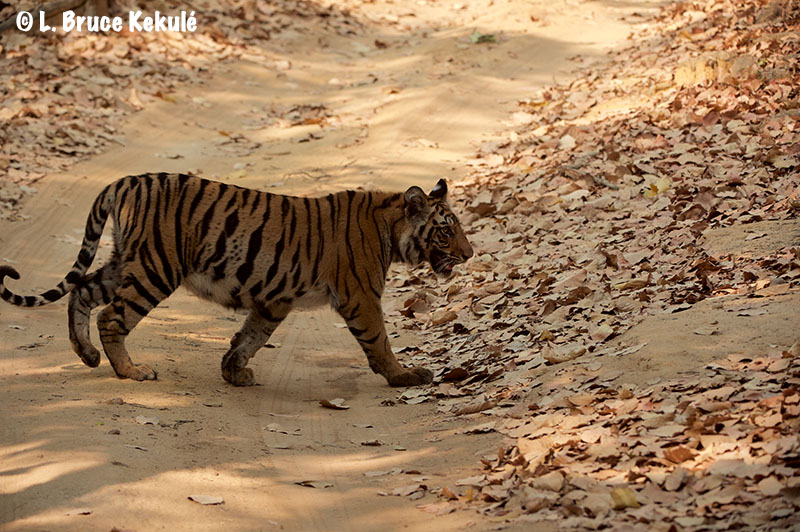


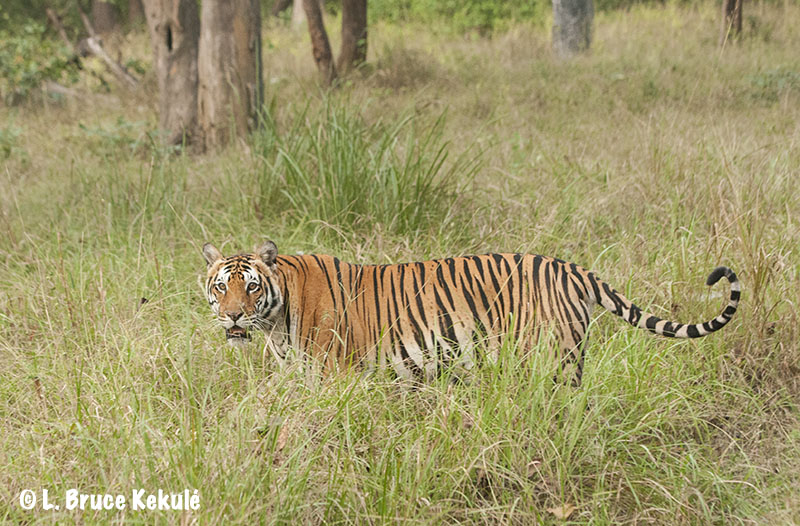
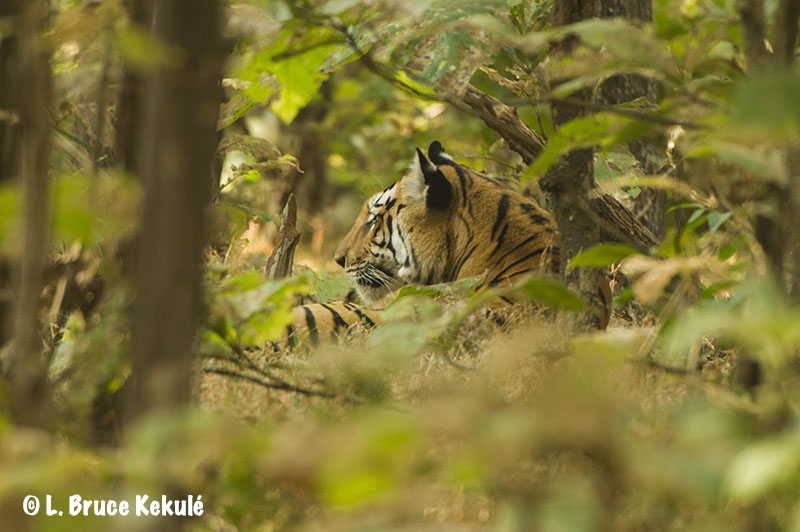

 tev
tev




